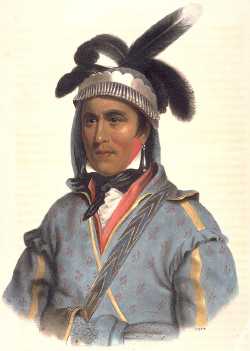 SKC Films Library |
| SKC Films Library >> American History >> Indians of North America >> Tribal and Individual Biographies |
| Opothleyahola leader in the Creek Confederacy who tried to avoid war with the United States by leading his people to sanctuary in Kansas
Opothleyahola was born in present-day Elmore County, Alabama, in 1798. He fought against the whites during the War of 1812, and during the Creek War of 1813-1814, including against General Andrew Jackson at the Battle of Horseshoe Bend. After these battles he swore to never again bear arms against the federal government. In 1825, several chiefs of the Creek Confederacy signed the Treaty of Indian Springs, giving up most of the remaining Creek lands in Georgia. The Creek National Council, led by Opothleyahola, protested that the treaty was fraudulent, however. Eventually the treaty was nullified by a new agreement, the Treaty of Washington (1826), but Georgia officials had already begun forcibly removing the Creek. After Alabama moved to abolish tribal governments and extend state laws over the Creeks, Opothleyahola appealed to President Andrew Jackson for appeasement, but none was forthcoming. Under terms of the Treaty of Cusseta, signed on March 24, 1832, the Creek lands were divided into individual allotments. Individual Creeks could either sell their allotments and receive funds to remove to the West, or stay in Alabama and submit to state laws. Opothleyahola chose to sell his allotment. In 1834, Opothleyahola went to Nacogdoches, Texas, seeking to purchase land to accomodate his people. Although he put down $20,000 of his own money, pressure from both the Mexican and American governments forced him to abandon the idea. In 1836, commissioned as a Colonel in the U.S. Army, Opothleyahola led 1,500 Creek warriors against rebellious Lower Creeks that had allied with Seminoles in fighting the white occupation. In 1837, he led 8,000 of his people from Alabama into the Indian Territory (now Oklahoma), during the infamous "Trail of Tears" march. He then became a wealthy trader and owned a 2,000-acre plantation near North Fork Town, complete with slaves. He also joined the Freemasons and became a Baptist. When the Civil War broke out, Opothleyahola refused to form an alliance with the Confederacy, unlike many other tribes. His plantation became home to runaway slaves, free blacks, and Chickasaw and Seminole Indians, all of whom hoped to remain neutral in the conflict. On August 15, 1861, Opothleyahola contacted President Abraham Lincoln to request help for his "followers." On September 10, he received a response stating that the federal government would indeed assist them, but they would first have to make their way to Fort Row in Wilson County, Kansas. On November 15, Confederate Colonel Douglas H. Cooper led 1,400 men, including blacks and pro-Confederate Indians, northward to convince Opothleyahola and his followers to either join the Confederacy or face being driven from the country. Believing the government's promises of assistance, Opothleyahola led his band toward Kansas, fighting three battles against Cooper along the way. Only 7,000 of the 9,000 Indians who started the journey survived the battles, disease, and bitter winter weather to reach Fort Row. Upon reaching Fort Row, they found that none of the supplies or military support had been delivered as promised, and they were forced to move on to Fort Belmont, in present-day Woodson County. Conditions were not much better there, so the remaining healthy moved again, this time to Coffey County, where the Superintendent of Southern Indians was headquartered. Opothleyahola died in the refugee camp at Quenemo in Osage County, Kansas, in 1863. SEE ALSO |
| SKC Films Library
>> American History
>> Indians of
North America >> Tribal and Individual
Biographies This page was last updated on 09/24/2017. |
